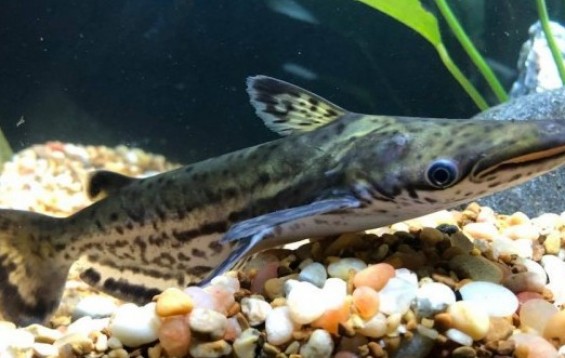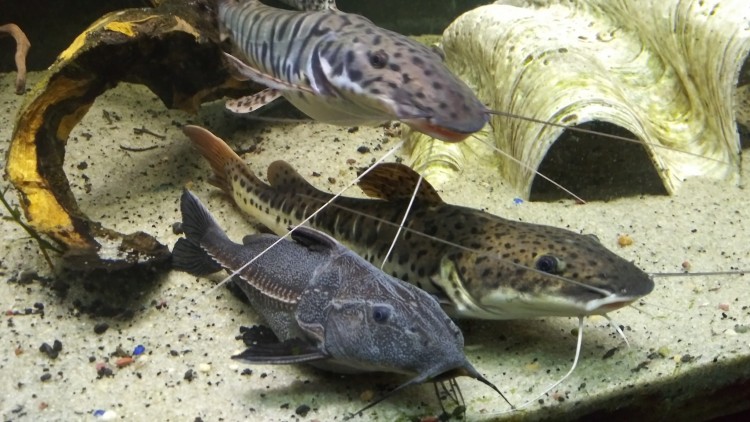- Name:
Bottlenose catfish
- Family: Auchenipteridae
- Species: Catfish
- Scientific Name: Ageneiosus marmoratus


More Details
General info about Bottlenose catfish
The Bottlenose catfish (Ageneiosus marmoratus) is a freshwater fish species belonging to the family Ageneiosidae, native to the Amazon and Orinoco river basins in South America. It is also known by other common names such as marbled headstander, marbled catfish, and Granulated catfish. The species can reach up to 50 cm (20 inches) in length and has a lifespan of up to 10 years.
The Bottlenose catfish have sharp pectoral fins that can cause injury if mishandled. It's essential to handle these fish with care to avoid injury to both the fish and the handler.
Bottlenose catfish Diet & Nutrition
The Bottlenose catfish is an omnivorous fish species and feeds on a wide variety of food sources, including small fish, crustaceans, insects, and plant matter. In captivity, they can be fed a diet of high-quality pellets, frozen or live foods such as bloodworms, brine shrimp, and krill.
Determining Sex of Bottlenose catfish
Sexual dimorphism is not very pronounced in the Bottlenose catfish. Males are generally larger than females and have a broader head and longer pectoral fins. However, the best way to determine the sex of these fish is by examining their genital papillae, which are longer and more pointed in males.
Breeding & Spawning Bottlenose catfish
Breeding Bottlenose catfish in captivity is not very common. In their natural habitat, they usually spawn during the rainy season when water levels rise, and the water becomes slightly acidic. During spawning, the male fertilizes the eggs that are deposited on submerged vegetation or rocks. The fry hatch within a week and are guarded by the male until they are strong enough to swim on their own.
Common Diseases with Bottlenose catfish
The Bottlenose catfish is generally a hardy fish species and is not prone to many diseases if kept in a clean and well-maintained aquarium. However, like all fish species, they are susceptible to bacterial and fungal infections, which can be caused by poor water quality or stress.
Bottlenose catfish Origin
The Bottlenose catfish is native to the Amazon and Orinoco river basins in South America, where it is found in slow-moving rivers, streams, and tributaries with sandy or muddy bottoms.
Caution with Bottlenose catfish
The Bottlenose catfish is generally a peaceful and non-aggressive fish species. However, they have been known to eat smaller fish that can fit in their mouth, and it's essential to keep them with appropriate tankmates that are not small enough to be seen as prey.
Acclimating Bottlenose catfish
The acclimation process for the Bottlenose catfish is similar to other fish species. They should be gradually introduced to their new aquarium by floating the bag they came in on the surface of the aquarium for about 20-30 minutes. Then, small amounts of aquarium water should be added to the bag every 10-15 minutes until the bag is full, and the fish are ready to be released.
Relevent Articles
Original Detail
| Name | Species | Family | Scientific Name | More Detail | Added by |
|---|---|---|---|---|---|
| Bottlenose catfish | Catfish | Auchenipteridae | Ageneiosus marmoratus | The Bottlenose catfish (Ageneiosus marmoratus) is a freshwater fish species belonging to the family Ageneiosidae, native to the Amazon and Orinoco river basins in South America. It is also known by other common names such as marbled headstander, marbled catfish, and Granulated catfish. The species can reach up to 50 cm (20 inches) in length and has a lifespan of up to 10 years. The Bottlenose catfish have sharp pectoral fins that can cause injury if mishandled. It's essential to handle these fish with care to avoid injury to both the fish and the handler. | PalaciosAn |
Changed by users
| Submitted Date | Submitted By | Status | Action |
|---|



